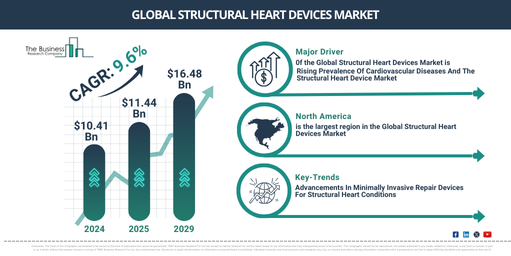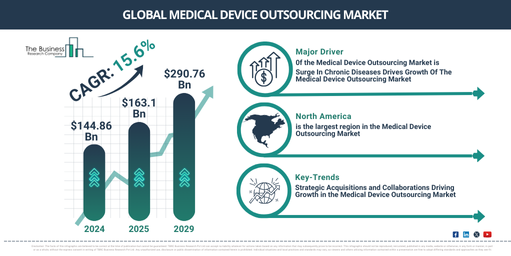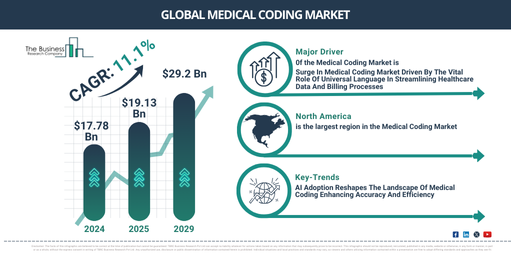In-Depth Insights into the Structural Heart Devices Market: Growth, Trends, and Opportunities for 2025-2034
Updated 2025 Market Reports Released: Trends, Forecasts to 2034 – Early Purchase Your Competitive Edge Today!
What Are the Projected Expansion Rates of the Structural Heart Devices Market for the Next Decade?
The market for structural heart devices has seen robust growth in recent years. It’s anticipated to increase from $10.41 billion in 2024 to $11.44 billion in 2025, representing a compound annual growth rate (CAGR) of 9.9%. The growth observed during the historical period can be credited to a movement towards less invasive surgical methods, a growing demand for minimally invasive structural heart devices, the continuation of training and educational programs for healthcare professionals, increased spending in healthcare, and a rise in patient preference for non-surgical or minimally invasive treatment alternatives.
In the coming years, the structural heart devices market is projected to witness significant growth, with a predicted value of $16.48 billion in 2029 at a compound annual growth rate (CAGR) of 9.6%. Factors such as an aging population, greater recognition of cardiac health, the launch of screening programs, favorable payment plans for structural heart operations, and prompt regulatory approval for new structural heart devices all contribute to this anticipated growth. Key trends within this period include a rise in transcatheter valve replacement, continued development of innovative devices using advanced materials, an increased focus on individualized treatment strategies, growing acceptance of hybrid procedures, and the addition of remote monitoring and telehealth solutions.
What Market Dynamics Are Playing a Key Role in Accelerating the Growth of the Structural Heart Devices Market?
The escalation in cardiovascular diseases is projected to drive the expansion of the structural heart device market. Cardiovascular diseases are a collection of afflictions that impact the heart and blood vessels, encompassing issues like coronary artery disease, strokes, and heart attacks. Sedentary living, poor eating habits, climbing obesity figures, smoking, and an elderly population have led to a constant rise in these diseases globally. Structural heart devices are used to treat cardiovascular diseases by mending or replacing defected heart valves, fixing structural faults, and fostering heart function and patient results. For example, the British Heart Foundation released data in September 2024 showing roughly 7.6 million people in the UK have heart and circulatory diseases, including about 4 million men and 3.6 million women. These ailments cause about 27% of all UK deaths, or over 170,000 deaths per year, which breaks down to around 480 deaths per day or one death every three minutes. Consequently, the growing prevalence of cardiovascular diseases is propelling the enlargement of the structural heart device market.
Get Your Free Sample of the Global Structural Heart Devices Market Report Now!
https://www.thebusinessresearchcompany.com/sample.aspx?id=15677&type=smp
Which Companies Are Redefining the Future of the Structural Heart Devices Market?
Major companies operating in the structural heart devices market are:
• Abbott Laboratories
• Medtronic Plc
• Boston Scientific Corporation
• Terumo Corporation
• Edwards Lifesciences Corporation
What Trends Are Poised to Drive the Future Success of the Structural Heart Devices Market?
Key players in the structural heart devices industry are innovating with minimally invasive procedures and devices to improve the outcomes for patients, decrease recovery times, and broaden the range of treatments for structural heart ailments. A self-expanding transcatheter aortic valve implantation (TAVI) system is a specialized device for positioning and anchoring a replacement valve in the innate anatomy of the aortic valve, with no need for balloon inflation. In reference to this, Abbott Laboratories, a U.S. firm that produces medical devices and healthcare goods, introduced Navitor, their next generation TAVI system in India in December 2022. Navitor is customized for those suffering from severe aortic stenosis who are at high or extreme surgical risk and it incorporates advanced features such as a unique design to prevent valve leakage. This product enhances Abbott’s portfolio of structural heart transcatheter devices, providing physicians and patients with more minimally invasive options for treating heart conditions. Navitor is unique as the only self-expanding TAVI system equipped with intra-annular leaflets and large frame cells, hence improving access to coronary arteries for prospective interventions in coronary artery disease (CAD). Additionally, the new design improves hemodynamics, thereby optimising blood circulation.
Get Instant Access to the Global Structural Heart Devices Market Report with Swift Delivery!
https://www.thebusinessresearchcompany.com/report/structural-heart-devices-global-market-report
What Are the Major Segments of the Structural Heart Devices Market and Their Role in Driving Growth?
The structural heart devices market covered in this report is segmented –
1) By Type: Heart Valve Devices, Annuloplasty Rings, Occluders, Delivery Systems
2) By Procedure: Replacement Procedures, Repair Procedures
3) By Indication: Atrial Septal Defect, Patent Foramen Ovale, Ventricular Septal Defect, Aortic Valve Stenosis, Other Indications
4) By Age Group: Pediatric, Adults
Subsegments:
1) By Heart Valve Devices: Transcatheter Heart Valves, Surgical Heart Valves, Annuloplasty Rings
2) By Annuloplasty Rings: Mitral Annuloplasty Rings, Aortic Annuloplasty Rings
3) By Occluders: Atrial Septal Defect (Asd) Occluders, Patent Foramen Ovale (Pfo) Occluders
4) By Delivery Systems: Balloon Delivery Systems, Catheter-Based Delivery Systems
What Are the Leading Regions in the Structural Heart Devices Market Expansion?
North America was the largest region in the structural heart devices market in 2024. Asia-Pacific is expected to be the fastest-growing region in the forecast period. The regions covered in the structural heart devices market report are Asia-Pacific, Western Europe, Eastern Europe, North America, South America, Middle East, Africa.
How Can We Define the Structural Heart Devices Market and Its Key Components?
Structural heart devices are specialized medical implants or tools designed for the treatment of various structural defects or abnormalities affecting the heart. It is used to repair or replace damaged heart structures, such as valves or septa, restoring normal heart functions and improving patient outcomes.
Browse Through More Similar Reports By The Business Research Company:
Heart Pump Devices Global Market Report 2024
https://www.thebusinessresearchcompany.com/report/heart-pump-devices-global-market-report
Implantable Heart Pacemaker Global Market Report 2024
https://www.thebusinessresearchcompany.com/report/implantable-heart-pacemaker-global-market-report
Prosthetic Heart Valve Devices And Equipment Global Market Report 2024
About The Business Research Company:
With over 15000+ reports from 27 industries covering 60+ geographies, The Business Research Company has built a reputation for offering comprehensive, data-rich research and insights. Armed with 1,500,000 datasets, the optimistic contribution of in-depth secondary research, and unique insights from industry leaders, you can get the information you need to stay ahead in the game.
Contact us at:
The Business Research Company: https://www.thebusinessresearchcompany.com/
Americas +1 3156230293
Asia +44 2071930708
Europe +44 2071930708
Email us at [email protected]
Follow us on:
LinkedIn: https://in.linkedin.com/company/the-business-research-company
YouTube: https://www.youtube.com/channel/UC24_fI0rV8cR5DxlCpgmyFQ
Global Market Model: https://www.thebusinessresearchcompany.com/global-market-model
Found this article helpful? Share it on:



